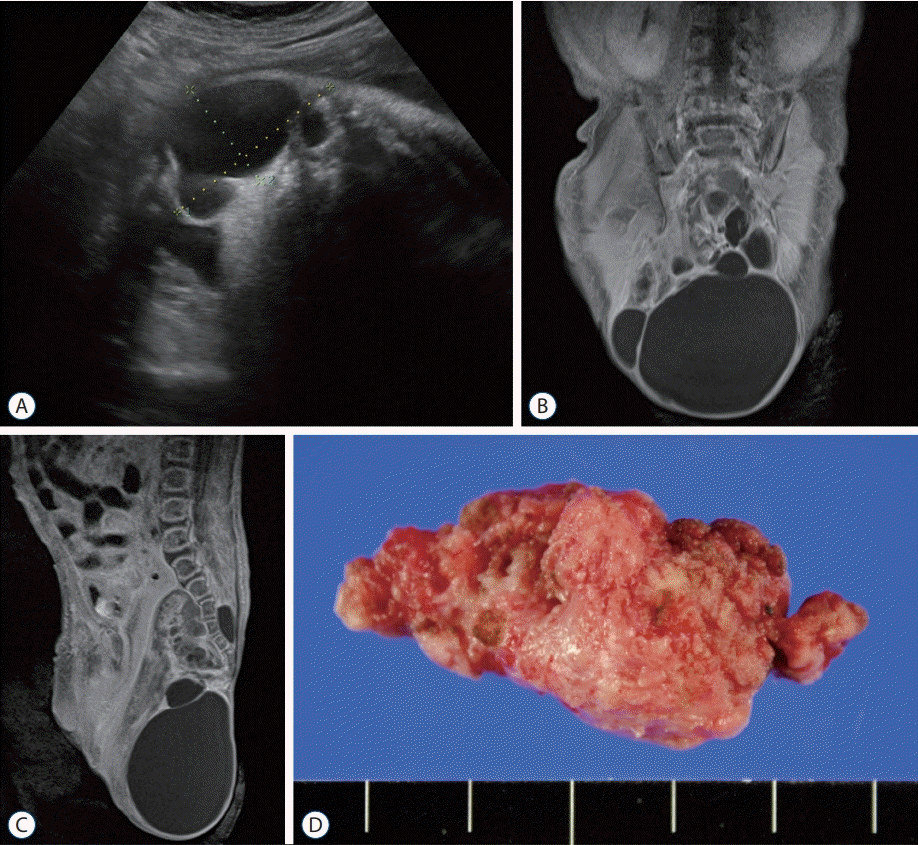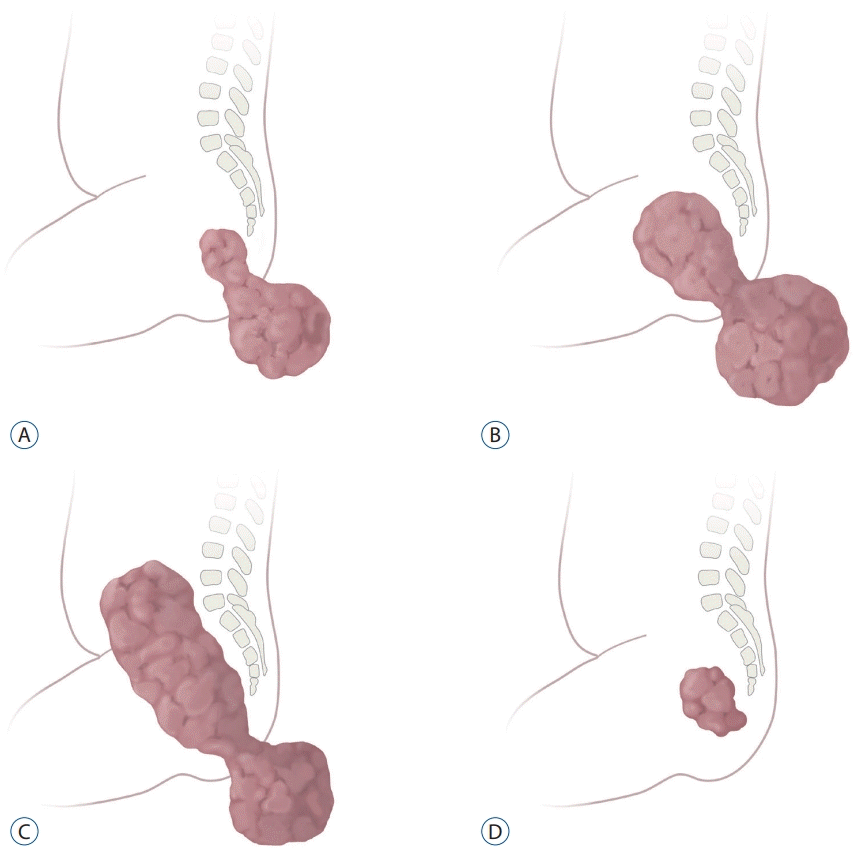1. Altman RP, Randolph JG, Lilly JR. Sacrococcygeal teratoma: American academy of pediatrics surgical section survey-1973. J Pediatr Surg. 9:389–398. 1974.

2. Anteby EY, Yagel S. Route of delivery of fetuses with structural anomalies. Eur J Obstet Gynecol Reprod Biol. 106:5–9. 2003.

3. Bader D, Riskin A, Vafsi O, Tamir A, Peskin B, Israel N, et al. Alphafetoprotein in the early neonatal period--a large study and review of the literature. Clin Chim Acta. 349:15–23. 2004.

4. Barksdale EM Jr, Obokhare I. Teratomas in infants and children. Curr Opin Pediatr. 21:344–349. 2009.

5. Cowles RA, Stolar CJ, Kandel JJ, Weintraub JL, Susman J, Spigland NA. Preoperative angiography with embolization and radiofrequency ablation as novel adjuncts to safe surgical resection of a large, vascular sacrococcygeal teratoma. Pediatr Surg Int. 22:554–556. 2006.

6. Damjanov I, Solter D, Belicza M, Skreb N. Teratomas obtained through extrauterine growth of seven-day mouse embryos. J Natl Cancer Inst. 46:471–475. 1971.
7. Derikx JP, De Backer A, van de Schoot L, Aronson DC, de Langen ZJ, van den Hoonaard TL, et al. Long-term functional sequelae of sacrococcygeal teratoma: a national study in the Netherlands. J Pediatr Surg. 42:1122–1126. 2007.

8. Ferlay J, Soerjomataram I, Dikshit R, Eser S, Mathers C, Rebelo M, et al. Cancer incidence and mortality worldwide: sources, methods and major patterns in GLOBOCAN 2012. Int J Cancer. 136:E359–E386. 2015.

9. Fumino S, Tajiri T, Usui N, Tamura M, Sago H, Ono S, et al. Japanese clinical practice guidelines for sacrococcygeal teratoma, 2017. Pediatr Int. 61:672–678. 2019.

10. Gabra HO, Jesudason EC, McDowell HP, Pizer BL, Losty PD. Sacrococcygeal teratoma--a 25-year experience in a UK regional center. J Pediatr Surg. 41:1513–1516. 2006.

11. Gross SJ, Benzie RJ, Sermer M, Skidmore MB, Wilson SR. Sacrococcygeal teratoma: prenatal diagnosis and management. Am J Obstet Gynecol. 156:393–396. 1987.

12. Hedrick HL, Flake AW, Crombleholme TM, Howell LJ, Johnson MP, Wilson RD, et al. Sacrococcygeal teratoma: prenatal assessment, fetal intervention, and outcome. J Pediatr Surg. 39:430–438. 2004.

13. Izant RJ Jr, Filston HC. Sacrococcygeal teratomas. Analysis of forty-three cases. Am J Surg. 130:617–621. 1975.
14. Keslar PJ, Buck JL, Suarez ES. Germ cell tumors of the sacrococcygeal region: radiologic-pathologic correlation. Radiographics. 14:607–620. quiz 621-622. 1994.

15. Köchling J, Pistor G, Märzhäuser Brands S, Nasir R, Lanksch WR. The Currarino syndrome--hereditary transmitted syndrome of anorectal, sacral and presacral anomalies. Case report and review of the literature. Eur J Pediatr Surg. 6:114–119. 1996.

16. Kratz CP, Mai PL, Greene MH. Familial testicular germ cell tumours. Best Pract Res Clin Endocrinol Metab. 24:503–513. 2010.

17. Kremer MEB, Althof JF, Derikx JPM, van Baren R, Heij HA, Wijnen MHWA, et al. The incidence of associated abnormalities in patients with sacrococcygeal teratoma. J Pediatr Surg. 53:1918–1922. 2018.

18. Lahdes-Vasama TT, Korhonen PH, Seppänen JM, Tammela OK, Iber T. Preoperative embolization of giant sacrococcygeal teratoma in a premature newborn. J Pediatr Surg. 46:e5–e8. 2011.

19. Litchfield K, Summersgill B, Yost S, Sultana R, Labreche K, Dudakia D, et al. Whole-exome sequencing reveals the mutational spectrum of testicular germ cell tumours. Nat Commun. 6:5973. 2015.

20. Lobo J, Gillis AJM, Jerónimo C, Henrique R, Looijenga LHJ. Human germ cell tumors are developmental cancers: impact of epigenetics on pathobiology and clinic. Int J Mol Sci. 20:258. 2019.

21. Lynch SA, Wang Y, Strachan T, Burn J, Lindsay S. Autosomal dominant sacral agenesis: Currarino syndrome. J Med Genet. 37:561–566. 2000.

22. Mamsen LS, Brøchner CB, Byskov AG, Møllgard K. The migration and loss of human primordial germ stem cells from the hind gut epithelium towards the gonadal ridge. Int J Dev Biol. 56:771–778. 2012.

23. Mann JR, Gray ES, Thornton C, Raafat F, Robinson K, Collins GS, et al. Mature and immature extracranial teratomas in children: the UK Children’s Cancer Study Group Experience. J Clin Oncol. 26:3590–3597. 2008.

24. Masahata K, Ichikawa C, Makino K, Abe T, Kim K, Yamamichi T, et al. Long-term functional outcome of sacrococcygeal teratoma after resection in neonates and infants: a single-center experience. Pediatr Surg Int. 36:1327–1332. 2020.

25. Monk D, Mackay DJG, Eggermann T, Maher ER, Riccio A. Genomic imprinting disorders: lessons on how genome, epigenome and environment interact. Nat Rev Genet. 20:235–248. 2019.

26. Murphy JJ, Blair GK, Fraser GC. Coagulopathy associated with large sacrococcygeal teratomas. J Pediatr Surg. 27:1308–1310. 1992.

27. Oosterhuis JW, Looijenga LHJ. Human germ cell tumours from a developmental perspective. Nat Rev Cancer. 19:522–537. 2019.

28. Oosterhuis JW, Stoop H, Honecker F, Looijenga LH. Why human extragonadal germ cell tumours occur in the midline of the body: old concepts, new perspectives. Int J Androl. 30:256–263. discussion 263-264. 2007.

29. Padilla BE, Vu L, Lee H, MacKenzie T, Bratton B, O’Day M, et al. Sacrococcygeal teratoma: late recurrence warrants long-term surveillance. Pediatr Surg Int. 33:1189–1194. 2017.

30. Partridge EA, Canning D, Long C, Peranteau WH, Hedrick HL, Adzick NS, et al. Urologic and anorectal complications of sacrococcygeal teratomas: prenatal and postnatal predictors. J Pediatr Surg. 49:139–142. discussion 142-143. 2014.

31. Pauniaho SL, Heikinheimo O, Vettenranta K, Salonen J, Stefanovic V, Ritvanen A, et al. High prevalence of sacrococcygeal teratoma in Finland - a nationwide population-based study. Acta Paediatr. 102:e251–e256. 2013.

32. Phi JH, Wang KC, Kim SK. Intracranial germ cell tumor in the molecular era. J Korean Neurosurg Soc. 61:333–342. 2018.

33. Poynter JN, Hooten AJ, Frazier AL, Ross JA. Associations between variants in KITLG, SPRY4, BAK1, and DMRT1 and pediatric germ cell tumors. Genes Chromosomes Cancer. 51:266–271. 2012.

34. Rattan KN, Singh J. Neonatal sacrococcygeal teratoma: our 20-year experience from a tertiary care centre in North India. Trop Doct. 49475520973616. 2020.

35. Rescorla FJ, Sawin RS, Coran AG, Dillon PW, Azizkhan RG. Long-term outcome for infants and children with sacrococcygeal teratoma: a report from the Childrens Cancer Group. J Pediatr Surg. 33:171–176. 1998.

36. Robertson FM, Crombleholme TM, Frantz ID 3rd, Shephard BA, Bianchi DW, D’Alton ME. Devascularization and staged resection of giant sacrococcygeal teratoma in the premature infant. J Pediatr Surg. 30:309–311. 1995.

37. Sananes N, Javadian P, Schwach Werneck Britto I, Meyer N, Koch A, Gaudineau A, et al. Technical aspects and effectiveness of percutaneous fetal therapies for large sacrococcygeal teratomas: cohort study and literature review. Ultrasound Obstet Gynecol. 47:712–719. 2016.

38. Schneider DT, Wessalowski R, Calaminus G, Pape H, Bamberg M, Engert J, et al. Treatment of recurrent malignant sacrococcygeal germ cell tumors: analysis of 22 patients registered in the german protocols MAKEI 83/86, 89, and 96. J Clin Oncol. 19:1951–1960. 2001.

39. Schropp KP, Lobe TE, Rao B, Mutabagani K, Kay GA, Gilchrist BF, et al. Sacrococcygeal teratoma: the experience of four decades. J Pediatr Surg. 27:1075–1078. discussion 1078-1079. 1992.

40. Shen H, Shih J, Hollern DP, Wang L, Bowlby R, Tickoo SK, et al. Integrated molecular characterization of testicular germ cell tumors. Cell Rep. 23:3392–3406. 2018.
41. Sobis H, Vandeputte M. Yolk sac-derived rat teratomas are not of germ cell origin. Dev Biol. 51:320–323. 1976.

42. Teilum G, Albrechtsen R, Norgaard-Pedersen B. The histogeneticembryologic basis for reappearance of alpha-fetoprotein in endodermal sinus tumors (yolk sac tumors) and teratomas. Acta Pathol Microbiol Scand A. 83:80–86. 1975.

43. van Heurn LJ, Knipscheer MM, Derikx JPM, van Heurn LWE. Diagnostic accuracy of serum alpha-fetoprotein levels in diagnosing recurrent sacrococcygeal teratoma: a systematic review. J Pediatr Surg. 55:1732–1739. 2020.

44. Van Mieghem T, Al-Ibrahim A, Deprest J, Lewi L, Langer JC, Baud D, et al. Minimally invasive therapy for fetal sacrococcygeal teratoma: case series and systematic review of the literature. Ultrasound Obstet Gynecol. 43:611–619. 2014.

45. Yao W, Li K, Zheng S, Dong K, Xiao X. Analysis of recurrence risks for sacrococcygeal teratoma in children. J Pediatr Surg. 49:1839–1842. 2014.

46. Yoneda A, Usui N, Taguchi T, Kitano Y, Sago H, Kanamori Y, et al. Impact of the histological type on the prognosis of patients with prenatally diagnosed sacrococcygeal teratomas: the results of a nationwide Japanese survey. Pediatr Surg Int. 29:1119–1125. 2013.

47. Yoon HM, Byeon SJ, Hwang JY, Kim JR, Jung AY, Lee JS, et al. Sacrococcygeal teratomas in newborns: a comprehensive review for the radiologists. Acta Radiol. 59:236–246. 2018.

48. Yoshida M, Tanaka M, Gomi K, Ohama Y, Kigasawa H, Iwanaka T, et al. Malignant steroidogenic tumor arising from sacrococcygeal mature teratoma. Hum Pathol. 42:1568–1572. 2011.







 PDF
PDF Citation
Citation Print
Print



 XML Download
XML Download